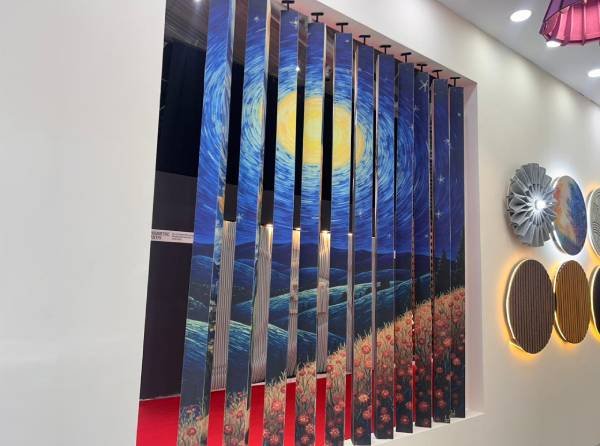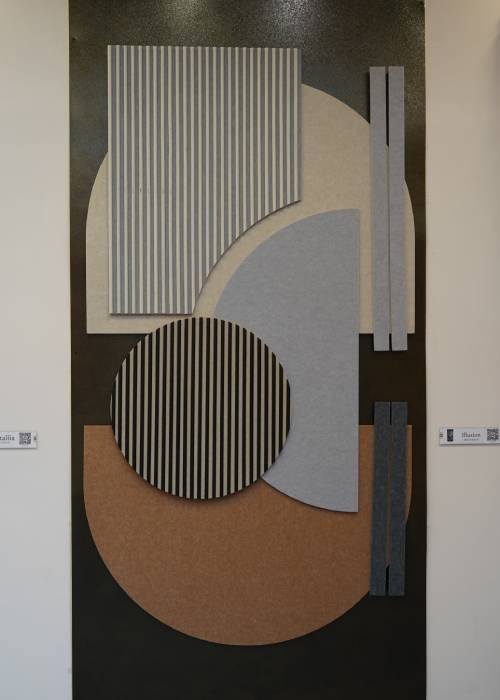Acoustic boards help lessen undesirable reflected sound in any room...
Polyester sound-absorbing panels are made from 100 per cent Polyester Acoustic fibre as raw material after being hot-pressed into a cotton cocoon shape to achieve diversity density and ensure ventilation by heat treatment law, making it an excellent product finish, sound-absorbing, heat-insulating materials, with the advantages of simple construction, strong decoration, style, rich colours, and other advantages.
Polyester Yarn is a synthetic textile fibre with a long chain that is widely used in the medical, bedding, clothing, geotextile, and construction industries. Polyester Material is very advantageous for a variety of products because it is safe, non-toxic, light weight, and has a high tensile strength and robustness. It’s also resistant to moisture, making it suitable for products like insulation and soundproofing.


Polyester fibre sound-absorbing board content can make indoor shape design more versatile and rich, and even art paintings can be copied through the machine in the polyester fibre board, which is commonly used in conference rooms, television studios, theatres, audio-visual, opera, leisure entertainment city, hotel, multi-function space, music hall, bar, restaurant, shopping malls, and so on. Professional construction workers should pay attention to the following aspects when installing polyester fibre sound-absorbing boards:
Natural fibres have been widely used in the creation of eco-friendly composite materials. Natural fibres, such as bamboo, hemp, and coconut shells, have a lot of potential for replacing costly synthetic fibres in acoustic absorption boards because of their abundance, low processing costs, and natural cellular structure, which can absorb acoustic waves effectively.
In the high frequency field, the sound absorption coefficient calculated by the impedance tube method was higher for porous fabrics than for dense fabrics. By the reverberant field method, the sound absorption coefficients for all fabrics were highest in the low frequency region. Because of their strong sound absorption property, porous fabrics had a shorter reverberation period and a higher sound absorption coefficient than dense fabrics.
Polyester fibres from Unidus are used to create smooth, fluffy, acoustic, and thermal insulation rolls, batts, and sheets. The substance is made with a heavy density for soundproofing and acoustic purposes. In general, the higher the density, the better the soundproofing. Australia Soundproofing Products Polyester Batts have no added formaldehyde binders, so they’re itch-free, and they don’t need any protective clothing to instal, so they’re a healthy choice for you and your family.
Our Polyester Soundproofing Products from Unidus also have a Zero Ozone Depleting (ODP) ranking, contain negligible Volatile Organic Compounds (VOC’s) and 80 percent of the fibres that go into Polyester Batts are recycled from plastic bags & other packaging materials, so they are better for the earth too. Polyester also complies with AS/NZS1530.3, an Australian fire safety standard.
Polyester fibre panels, with 100% polyester fibre as raw material, after hot forming, due to different production batches of coloured silk, in light of the role that is easy to produce small colour differences, at the time of purchase to use polyester fibre sound-absorbing board production with the same batch number, prior to the construction of the polyester fibre panels are arranged in a grid.
Noise has been one of the world’s four main emission forms. Constant noise exposure can lead to a variety of health issues, including hearing loss, cardiovascular disease, and sleep disturbances. It is critical to develop materials that are both cost-effective and environmentally friendly in order to reduce noise pollution
Acoustic boards help lessen undesirable reflected sound in any room...
Acoustic boards help lessen undesirable reflected sound in any room...
Open spaces have been known as the trending layout for...
WhatsApp us